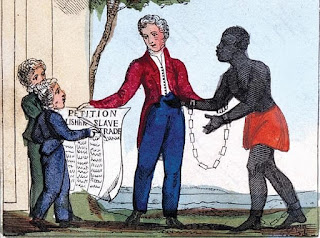 |
| By Jos. A. Beard [Public domain], via Wikimedia Commons |
Val continued here
efforts at Slavery looking at the The Legal Status of Slaves in Britain.
Because slavery was
such a lucrative business seen by many as essential to the British economy legal
rulings on the subject were often ambiguous and open to conflicting
interpretation. Central to the economics of the slave trade were the Navigation
Acts which were based on monopoly principals designed to ensure that trade
between Britain and her colonies was carried out only on British ships.
In 1677 an appeal
was made to the Solicitor General to rule whether African slaves could be
regarded as goods in conforming with the Navigation Acts controlling the
regulation of trade. The Solicitor general rule unequivocally that as slaves
were generally bought and sold they should be esteemed as goods and commodities.
Whether intended or
not this ruling permitted salve owners to treat slaves as they would any other
property. This process of dehumanising African men and women was reinforced when
in 1729 the Solicitor general ruled that a salve coming to Britain did not become
free and the master could legally compel him to return to the plantation
despite the fact that English law gave every resident protection against
illegal imprisonment or removal to a foreign country.
In 1769 James
Somerset, the property of a Boston customs official named Charles Stewart was
brought to England as a personal domestic slave.
In 1771 he ran away
but was recaptured and placed on a ship bound for Jamaica where he was to be
sold.
Anti slavery
campaigner Granville Sharp took up his case and obtained a writ requiring him
to be removed from the ship and brought before a judge.
In court Somersets
legal team argued that although slavery was tolerated in the colonies English
law did not allow a master to take a slave from England by force and sell him
abroad because he had deserted his service.
On this occasion the
Lord Chief Justice Lord Mandsfield agreed and describing slavery as odious
ruled that Somerset must be discharged.
 |
| By Wesleyan Juvenile Offering [Public domain], via Wikimedia Commons |
Abolitionists and
slaves were initially overjoyed because the ruling was taken to mean that
slaves residing in Britain were now emancipated, but this was not the case, the
ruling was too narrow and slaves owners continued to capture runaways and
return them to the colonies usually without legal challenge.
In 1785 Lord Mansfield further ruled that black slaves in England were not entitled to be
paid for their labour, however, neither were they oblige to continue working for
their masters as slavery was not within the bounds of contract law. Following
the Abolition of the Slave Trade in 1807 greater clarification came when in
1824 the courts ruled that there was no statute recognising slavery in Britain.
The public widely understood this ruling to mean that on English soil at least
no man or woman was a slave but in legal terms the status of slaves in Britain
was still unclear.
Mary Ann Macham who
came to England as an escaped slave arrived in North Shields from Virginia on
Christmas day in 1831. Her mother was
to slavery rather than the freedom she enjoyed in the North east of
England.a slave, her farther the slave owner. She was 29 years old and this was
her first day of freedom.
She had crossed the
Atlantic on an English ship, the Atlas, heading for Grimsby but the ships mater
brought her to Tyneside. How she came to be aboard the Atlas is unclear. She
may have bought a passage herself or been supported by the 'undereground railway'
who helped 10,000 people flee the southern states.
Mary Ann found
refuge with the Spence family, North Shields, Quaker bankers and drapers. She
worked in domestic service until 1841 when at the age of 39 she married James
Blyth a local rope maker. The couple had no children and some time later James
died in 1877. Mary Ann moved in with her relatives of her late husband in
South Benwel.
In 1893 at the age
of 91 Mary Ann died and was buried in Preston Village. She had arrived in
England 2 years before the Abolition Act was passed. Had her master pursued her
she might well have been forcibly returned to Virginia and condemned to slavery rather
than the freedom she enjoyed in the North East of England.
Shelagh related and article in the Daily Mail in April 2018 entitled a Business Built around Slavery.
The following took place in a large old Edwardian house in Newcastle West End, the £225,000 pound property was rented by a Roma family from Slovakia who began their slave business in 20110. The perpetrators were all from one family who exploited the EU freedom of movement law; to traffic victims from Slovakia and the Czech Republic to their house in Newcastle. The Roma family known as the Rafaels paid a trafficker back home £300 for each victim that was sent to them in Newcastle.
The victims were from the poorest in society, some were homeless and living on the streets, none spoke English, they were promised a really good life in the U.K. if they were prepared to work hard. One of these poor vulnerable men and women arrived and were in the clutches of the Rafael family their passports were taken off them and they were told that if they ever went to the police to complain there was no hiding place, they would be found and suffer a horrendous death as would any family that they had back home.
The living conditions for those people was horrific, they lived in absolute squalor, they were given meagre amounts of food usually way past its sell by date.
The Rafaels used government agencies to find jobs for their victims, some of these jobs were in car Wash facilities or food packaging units, one man who worked twelve hours a day, received £10 a day as the Rafaels took the rest of his earnings from him. The Rafaels not only claimed fraudulent amounts of money for themselves but also for their victims. The Rafaels were living a life of luxury on the backs of their poor victims.
The bubble burst for the Rafaels when one of their victims went to the police.
The Rafaels were arrested and charged with slavery, trafficking, money laundering and fraud. The six Rafaels were given a jail sentence of thirty eight years between them and will be deported when their sentence has been served. The victims or slaves have now all been returned to Slovakia and the Czech Republic.
It is hard to believe that in the 21st century in our little corner of the world all this has been going on under our noses and none of us knew.
Moira talked about the Slave Trade and its comparisons with the production of sugar and cotton.
In the mid 17 century sugar cane was brought into what became the British West Indies by the Dutch from Brazil. Because of stiff competition from North American colonies the price of cotton and tobacco had decreased. Therefore the local growers were urged to change to sugar cane, this led to a boom in the Caribbean economics.
In 1807 annual incomes per estate of $4000 ($400,000 today) was not uncommon for sugar planters. The extreme cost was paid by enslaved Africans, whose working conditions were horrendous. They were made to work so hard that the labour force had to be renewed every decade due to the high death rate amongst the slaves. They were literally worked to death. The sugar islands became grave yards for the slaves.
Children were made to work the plantation crops from as young as five and on many plantations women were made to work throughout pregnantcy, their babies were raised in nurseries whilst their mothers worked all the daylight hours in the field. The owners used extreme violence on the enslaved labourers and the violent treatment is documented in narratives by Olaudah Equiano, Mary Price, Robert Wedderburn and Frederick Douglass. Despite the horrendous conditions, they tried hard to keep their humanity and dignity. An example of the sort of treatment can be found in the diary of Thomas Thistlewood an overseer on Egypt plantation which was west of Savanna la Mar in Jamaica, his sexual exploitation and treatment of the slaves under his charge is referred to by historian Trevor Bernard as being a brutal sociopath.
When freedom from slavery ended in the British Caribbean in 1838, the British continued to work the plantations using a new labour force brought from the Indian subcontinent. The Indian labour was called an indenture labour force. The workers came under a contract( an indenture), but under this contract they rarely made any money from their labour, despite long hours and tough conditions.
Between 1838 and 1918 over 1.5 million workers came from Asia to the British Caribbean alone. This contradicted British claims that they had been morally good in abolishing enforced labour regimes.
Our Next Meeting will be on Wednesday 13 June 10:30 at the Into Newcastle Cafe












